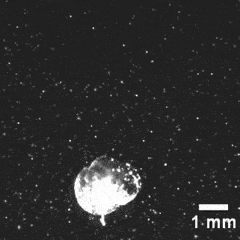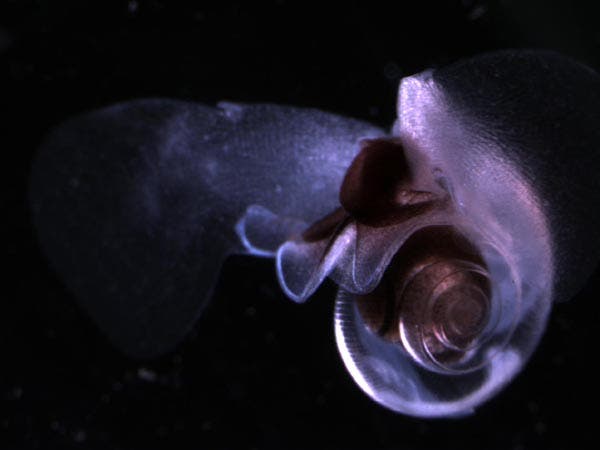Can you fly through water? It’s a silly thought, but that’s exactly what this snail butterfly, called Limacina helicina, seems to be doing. Researchers at Georgia Tech report that these sea snails flap their wings in a figure eight pattern very much akin to that used by airborne insects, like flies or bees.

Light reflecting particles allowed the researchers to carefully study the snail butterfly’s flapping pattern. Image: Georgia Tech
David W. Murphy, now working at Johns Hopkins, built a special apparatus for his doctoral thesis used to study the movements of millimeter sized plankton. Inside, four high speed cameras and two infrared lasers illuminate a cubic volume one inch on a side. When these fire, the pulses get reflected by special particles that dope the seawater inside the tank, revealing even the most minute changes in the water.

These animals are rather difficult to observe, since the shell (when present) is mostly colorless, very fragile and usually less than 1 cm in length. Image: Wikimedia Commons
This way, Murphy was able to discern the swirling patterns made by the sea butterfly during its watery flight. The pteropod, more commonly know as the sea butterfly, propels itself with fins that protrude from its transparent shell and flap like a butterfly’s wings. Studying them has proven difficult since they’re very fragile and the size of small pea.
Most zooplankton use their appendages as paddles to push themselves through the water, relying on drag to keep themselves in motion. To produce this figure eight pattern, the sea butterfly rotates its body via a maneuver called hyperpitching. The sea butterfly, however, flaps its wings a lot slower — just five beats per second compared to, say, 200 beats/second for a fruit fly.
It might seem counter-intuitive at first, but the two modes of locomotion — that of a flying insect and a sea snail — aren’t that different. One flies in the air, while the other flaps in the water. Both are fluids governed by same laws of physics. It’s just that water is more viscous, so the momentum from one flap is much greater than in the air.
The sea butterfly might help researchers make really maneuverable water bots, which might employ hyperpitching. Findings appeared in Journal of Experimental Biology.









